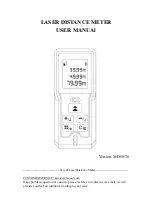
March 2008
3-8
Diagnostics
Clamp-on Transducer
Problems
1.
POOR COUPLING TO PIPE:
Clamp-on transducers must be in
close contact with the pipe. Make sure the pipe wall is smooth and
generally free of paint. The couplant material must fill voids
between the transducer and the pipe, and must be firmly coupled
or bonded to both the pipe and the transducer. The pipe and
transducer must be clean and dry for permanent couplant, such as
grease or epoxy, to adhere properly. Enough pressure must be
applied to the transducer by its clamp to hold it firmly against the
pipe.
2.
MISALIGNMENT:
The transducer transmits relatively narrow
beams of ultrasound; therefore, transducer alignment is critical to
assure that the beam can travel from one transducer to the other
without undue attenuation. Be sure to exactly follow the
instructions that came with your transducers and clamping
fixtures. Also, be sure that the transducer spacing agrees with the
calculated spacing (S).
3.
INTERNAL DAMAGE:
Ultrasonic transducers consist of a
ceramic “crystal” bonded to the transducer case. The bond
between the crystal and the case may be damaged by extreme
shock and by temperature extremes. The crystal itself can also be
damaged by the same conditions. The internal wiring can be
corroded or shorted if contaminants enter the transducer housing.
4.
PHYSICAL DAMAGE:
Transducers may be physically damaged
by dropping them onto a hard surface or striking them against
another object. Usually the connector on the transducers is the part
that is damaged, as it is the most fragile. Minor damage may be
repaired by carefully bending the connector back into shape. If the
connector cannot be repaired, replace the transducers.
IMPORTANT:
Transducers must be replaced in pairs. Refer to
Chapter 2,
Initial Setup
, of the
Startup Guide
to
program the replacement transducer data into the
meter.
5.
CYCLE SKIP CONDITION:
A cycle skip is usually caused by a
distorted or altered signal due to poor couplant, bad wall or
unusual fluid disturbances. To resolve a cycle skip, recouple both
transducers with proper couplant. Check your couplant for
temperature ranges. In addition, make sure the pipe wall is free of
paint and rust.
Contact the factory if you cannot solve a transducer-related problem.
Summary of Contents for DigitalFlow DF968
Page 2: ......
Page 7: ...Chapter 1 ...
Page 23: ...Chapter 2 ...
Page 32: ...Chapter 3 ...
Page 42: ...Chapter 4 ...
Page 55: ...Appendix A ...
Page 56: ...Service Record Introduction A 1 Data Entry A 1 ...
Page 60: ...Appendix B ...
















































